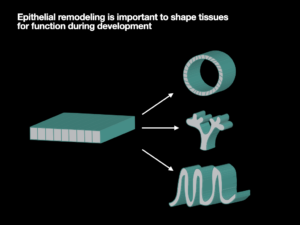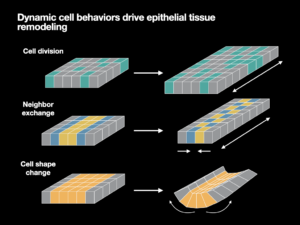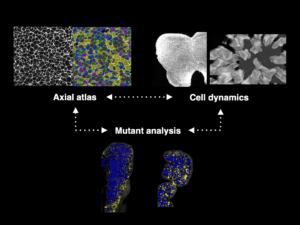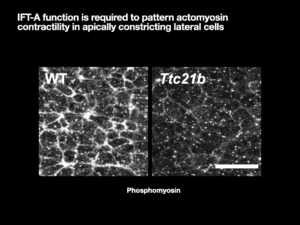Research
You can hear Eric give a brief overview of some of his work–courtesy of the Development Presents webinar series–here (link opens in new tab): https://www.youtube.com/watch?v=45YsauAB88U
General interests and approaches
During development tissues are reshaped into the three-dimensional conformations required for organ function 
This reshaping of tissues is accomplished by the coordination of dynamic changes at the level of individual cells, such as division, rearrangement of cells, or changes in individual cell shape 
Several critical tissue reshaping events occur in the early embryo as the basic body plan of the animal is laid out. One of these is neural tube closure. During this process a sheet of neuroepithelial cells undergoes a dramatic conformational change to form the neural tube, a closed and hollow structure that forms the structural basis of the brain and spinal cord. We are particularly interested in closure of the future brain, where the neuroepithelial sheet undergoes a dramatic curvature inversion.

We use a combination of mouse genetics, quantitative live and fixed imaging, molecular and cellular approaches to explore how neuroepithelial cells contribute to this large-scale tissue remodeling at the individual and ensemble levels.

Current research projects
1) How are spatial and temporal patterns of cell dynamics encoded in the tissue?
We have previously shown that Hedgehog signals arising from the midline have a profound impact on the spatial pattern of cell shape changes


We are now exploring what other spatial signals play a role in patterning cell dynamics, as well as how these patterns evolve over time
2) What are the molecular mechanisms underlying dynamic cell changes during closure?
We are also interested in how upstream signals are translated into downstream cell behaviors. For example, we have shown that changes in Hedgehog signaling can impact the pattern of the core actomyosin contractile machinery of the cell. However, many questions about how the initial signal is translated into the final pattern of contractility within the cell. Similarly, we are exploring the molecular mechanisms driving other dynamic changes in neuroepithelial cells.

3) How do environmental factors impact spatial signals and cell dynamics?
Environmental exposures and other exogenous factors impact neural tube closure. Some induce defects in closure and some provide protective outcomes. However, the impact of these exposures on the cell dynamics that drive closure often remain unknown. Further, the intersection of these exposures and the genetic pathways regulating closure remain opaque.